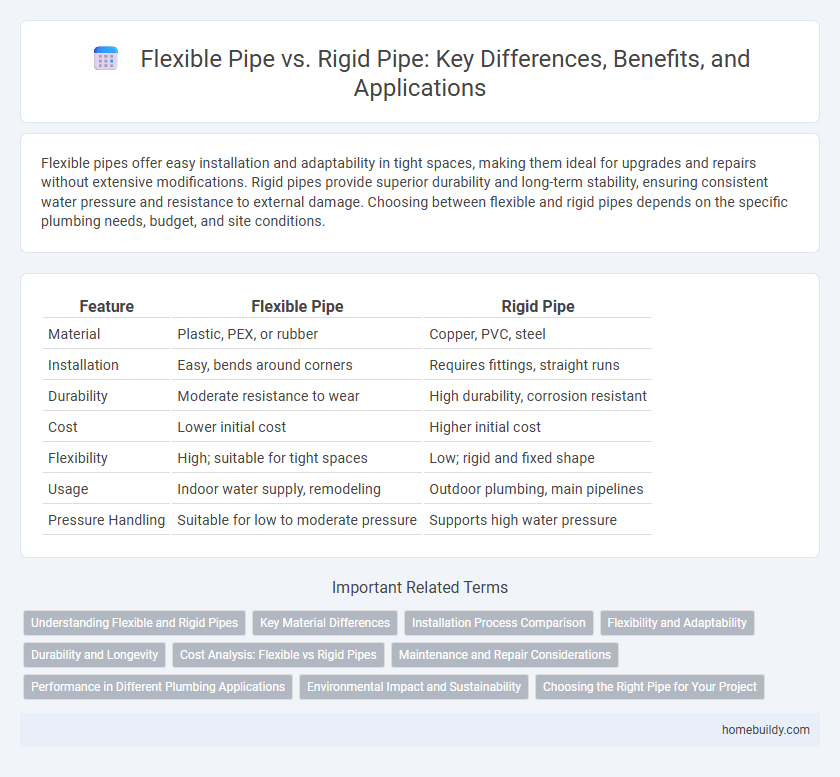Flexible pipes offer easy installation and adaptability in tight spaces, making them ideal for upgrades and repairs without extensive modifications. Rigid pipes provide superior durability and long-term stability, ensuring consistent water pressure and resistance to external damage. Choosing between flexible and rigid pipes depends on the specific plumbing needs, budget, and site conditions.
Table of Comparison
| Feature | Flexible Pipe | Rigid Pipe |
|---|---|---|
| Material | Plastic, PEX, or rubber | Copper, PVC, steel |
| Installation | Easy, bends around corners | Requires fittings, straight runs |
| Durability | Moderate resistance to wear | High durability, corrosion resistant |
| Cost | Lower initial cost | Higher initial cost |
| Flexibility | High; suitable for tight spaces | Low; rigid and fixed shape |
| Usage | Indoor water supply, remodeling | Outdoor plumbing, main pipelines |
| Pressure Handling | Suitable for low to moderate pressure | Supports high water pressure |
Understanding Flexible and Rigid Pipes
Flexible pipes offer superior adaptability and ease of installation in tight or complex spaces, commonly made from materials like PEX or corrugated stainless steel designed to resist corrosion and withstand varying pressures. Rigid pipes, such as PVC, copper, or galvanized steel, provide long-lasting durability and high strength, making them ideal for structural stability and long-distance water transport in plumbing systems. Understanding the specific application requirements and environmental conditions is essential for choosing between flexible and rigid pipes to ensure optimal performance and longevity.
Key Material Differences
Flexible pipes are typically made from materials like cross-linked polyethylene (PEX) or corrugated stainless steel, offering high resistance to corrosion, flexibility, and ease of installation in tight spaces. Rigid pipes, often composed of copper, PVC, or galvanized steel, provide superior durability, structural integrity, and resistance to high pressures but lack adaptability in complex plumbing layouts. The choice between flexible and rigid pipes depends on project requirements, with flexible pipes excelling in retrofit applications and rigid pipes preferred for long-lasting, high-pressure systems.
Installation Process Comparison
Flexible pipes offer a faster and more versatile installation process as they can easily bend around obstacles without requiring additional fittings, reducing labor time and costs. Rigid pipes, such as PVC or copper, demand precise measurements, cutting, and additional joints, making the installation more time-consuming and requiring skilled labor. The adaptability of flexible pipes makes them ideal for complex layouts, while rigid pipes are preferred for straight runs and long-term durability.
Flexibility and Adaptability
Flexible pipes offer superior adaptability in plumbing installations by easily bending around obstacles and fitting into tight spaces, reducing the need for additional joints or fittings. Rigid pipes provide strong structural integrity but lack the flexibility required for complex layouts or shifting environments. Choosing flexible pipes enhances ease of installation and maintenance in dynamic plumbing systems where movement or frequent adjustments occur.
Durability and Longevity
Flexible pipes, typically made from materials like PEX or rubber, offer excellent resistance to freezing and thawing cycles, reducing the risk of cracks and leaks, thus enhancing durability in varying climates. Rigid pipes, such as copper or PVC, provide superior longevity due to their robust structure and resistance to physical damage, making them ideal for permanent installations. While flexible pipes excel in adaptability and ease of installation, rigid pipes generally outperform in long-term durability and lifespan under consistent pressure and environmental conditions.
Cost Analysis: Flexible vs Rigid Pipes
Flexible pipes typically cost more upfront than rigid pipes due to materials and manufacturing complexity but reduce labor expenses with easier installation and fewer fittings. Rigid pipes, such as PVC or copper, are generally less expensive per foot but incur higher labor costs and longer installation times because of their inflexibility and the need for precise measurements and multiple joints. Evaluating total cost of ownership includes both material price and installation efficiency, often making flexible pipes more economical in complex plumbing systems.
Maintenance and Repair Considerations
Flexible pipes allow easier access for maintenance and repairs due to their bendable nature, reducing the need for extensive dismantling. Rigid pipes often require more complex repair processes, including cutting and fitting replacement sections, leading to increased labor time and costs. Choosing flexible piping can minimize downtime and simplify troubleshooting in plumbing systems.
Performance in Different Plumbing Applications
Flexible pipes excel in complex plumbing layouts due to their bendability and ease of installation, reducing the need for fittings and minimizing leakage points. Rigid pipes, such as copper or PVC, provide superior pressure resistance and durability, making them ideal for high-pressure water supply and long-term structural applications. Choosing between flexible and rigid pipes depends on specific performance requirements, including flexibility, pressure capacity, and environmental conditions.
Environmental Impact and Sustainability
Flexible pipes often have a lower environmental footprint due to reduced material usage and easier installation, which minimizes site disturbance and waste generation. Rigid pipes, typically made from metals or durable plastics, offer longer lifespans and higher recyclability rates, contributing to sustainable resource management. Selecting between flexible and rigid pipes requires assessing lifecycle impacts, including production emissions, transportation energy, and end-of-life recycling potential to optimize environmental sustainability.
Choosing the Right Pipe for Your Project
Flexible pipes offer superior adaptability and ease of installation in tight or complex spaces, making them ideal for renovations and smaller projects. Rigid pipes, such as PVC or copper, provide enhanced durability and pressure resistance, suitable for long-lasting, high-demand plumbing systems. Selecting the right pipe depends on project requirements, including space constraints, durability needs, and budget considerations.
Flexible Pipe vs Rigid Pipe Infographic

 homebuildy.com
homebuildy.com